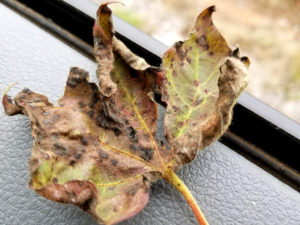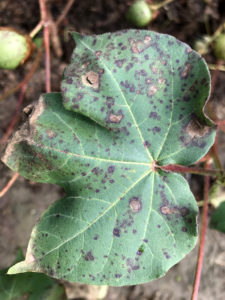High Plains, Rolling Plains cotton seeing premature defoliation
Writer: Kay Ledbetter, 806-677-5608, skledbetter@ag.tamu.edu
Contact: Dr. Tom Isakeit, 979-862-1340, t-isakeit@tamu.edu
Dr. Gaylon Morgan, 979-845-2425, gdmorgan@tamu.edu
Dr. Jason Woodward, 806-632-0762, jewoodward@ag.tamu.edu
Dr. Jourdan Bell, 806-677-5600, Jourdan.bell@ag.tamu.edu
Dr. Emi Kimura, 940-552-9941 x233, emi.kimura@ag.tamu.edu
AMARILLO – Cotton fields in the High Plains and Rolling Plains of Texas are experiencing browning or bronzing of the foliage, often accompanied by premature defoliation, Texas A&M AgriLife Extension Service experts are reporting.

Dr. Jason Woodward, AgriLife Extension plant pathologist in Lubbock, said he’s had more phone calls from farmers in the last 10 days to two weeks on this issue than any other before.
“We are seeing the issue primarily in the southern High Plains – Lubbock and north into the Amarillo area and into the Vernon area,” Woodward said. “I’ve seen samples, and it is widespread and quite obvious.”
He said the primary cause, alternaria leaf spot, is seen every year at low levels, but “the extremely wet conditions we’ve seen the last 10 days to two weeks is what has caused the acceleration this year.”
Even though the disease in fields looks bad, Woodward said, the weather is more of a factor than the disease.
“Cotton doesn’t like wet and overcast conditions,” he said. “It is more content with hot and sunny conditions.”

The redeeming factor is the leaf spot didn’t show up earlier in the year, Woodward said. Cotton harvest is rapidly approaching and this issue is occurring mostly in plants furthest along in a maturity standpoint, so the potential to greatly affect yields is limited this late in the year
“I feel like it is a late-season disease and the potential for yield loss is not as great as if the condition had occurred earlier in August,” he said.
Dr. Jourdan Bell, AgriLife Extension agronomist in Amarillo, said she believes the earlier maturing varieties are shutting down due to cool conditions in the northern High Plains. Under cool, wet conditions, the plant is more susceptible to alternaria resulting in premature defoliation.
She agreed with Woodward that it is the extended cool, wet period that is much to blame.
Another weather-related problem she noted was the shortage of remaining growing season.
“In the northern High Plains, we are potentially running out of time to mature the crop,” Bell said. “So, again the weather will be a bigger factor than the leaf spot in ultimate yields.”
Dr. Emi Kimura, AgriLife Extension agronomist in Vernon, said she started to see more leaf diseases and cotton root rot after a 4-6 inch rain event at the end of September in the Rolling Plains. The affected area shows browning of leaves in circular patterns in the field, and the affected areas seem to be spreading as rain continues to fall in the Rolling Plains.
She said they are recommending producers keep a good record of the problem areas within the fields so preventative measures can be utilized next year.
Dr. Tom Isakeit, plant pathologist, and Dr. Gaylon Morgan, state cotton specialist, both with AgriLife Extension in College Station, have been studying the problem in other parts of the state and determined several leaf spot diseases are associated with the affected foliage, but are secondary to nutrient deficiencies in the leaves.

Different species of fungi have been found to cause these leaf spots, Isakeit said. With cotton, the fungi are probably hastening the defoliation, but they are not likely the main factor in defoliation.
Disease development is associated with frequent rain, he said. This stress, combined with other factors, contributes to insufficient nutrient uptake to meet high boll demand, including potassium. While adequate soil potassium levels are generally present in most of the High Plains and Rolling Plains soils, a small root system caused by compaction can impact root uptake.
But the cooler, cloudy and wet weather are detrimental to healthy leaves and are also contributing to bronzing and yellowing of the leaves and premature defoliation, Morgan said.
On the positive side, he said, these potassium deficiency symptoms usually only occur in the High Plains and Rolling Plains when the cotton yield potential is high. Potassium, phosphorus and nitrogen are mobile within plants and are transported to the parts of the plant with the most demand.
In a crop with a heavy boll load, Morgan said these mobile nutrients will be translocated from the leaves to the developing bolls, causing various nutrient deficiencies in the leaves and can lead to secondary pathogen infections.
Development of leaf spot diseases very late in the season in conjunction with these nutrient deficiencies should have a minimal impact on cotton yield, he said. If the fungal epidemic occurred earlier in the season, it could have caused greater yield losses. At this point in the season, the need for more heat unit accumulation is the most yield limiting factor.
The application of fungicides to control fungal spots will not protect yield where the initial culprit is also a major, non-pathogenic stress, as has been seen in the High Plains and Rolling Plains, Isakeit said.
“We are saying foliar applications of fungicides are not recommended at this time,” he said.
Morgan also said in the later-planted fields just beginning to show symptoms, foliar applications of potassium may help elevate some deficiency symptoms, but have a very low likelihood of having a positive return on investment.
Previous research on foliar applications of potassium has shown inconsistent impacts on yield with early and mid-season applications and require multiple foliar applications to move sufficient levels of potassium into the plant through the leaves, he said. Research is ongoing to evaluate the value of foliar potassium applications in high yielding environments.
Planning for next year, Morgan said, the most important thing is to collect soil samples and get them analyzed to determine if adequate nutrients are available in the soil for use by the plant.
Once the soil test levels are known – preferably 0-6 inches and deeper samples – then the recommended balanced nutritional program should be implemented to meet the yield goal.
For more information, go to https://agrilife.org/texasrowcrops/ and https://cotton.tamu.edu.


